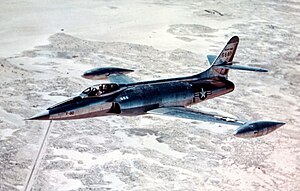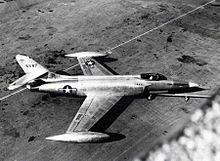Lockheed XF-90
| Lockheed XF-90 | |
|---|---|
 The first prototype of the Lockheed XF-90 |
|
| Type: | Fighter plane |
| Design country: | |
| Manufacturer: | |
| First flight: |
June 3, 1949 |
| Commissioning: |
Flight tests canceled |
| Production time: |
Was never mass-produced |
| Number of pieces: |
2 |
The Lockheed XF-90 was a fighter aircraft developed for the United States Army Air Forces (USAAF) in the late 1940s . Lockheed only produced two prototypes .
history
In August 1945 the US Air Force launched a tender for a new fighter aircraft. It was supposed to serve as an escort fighter for long-range bombers and therefore be able to demonstrate a long range. The requirements also included good nosedive skills, a top speed of at least 965 kilometers per hour and a deployment radius of 1,450 kilometers. The fighter should be single seated and equipped with swept wings and two jet engines. At least four on- board cannons , unguided air-to-air missiles and free-fall bombs were provided as armament .
Lockheed also took part in the competition, along with several other companies. From autumn 1945 onwards, under the project name L-153, a number of designs were created with the most varied of configurations, except for versions with delta wings , which bore the abbreviation L-167. In the spring of 1946, Lockheed's model was given the military designation XP-90, in-house it was now called the Model 90 . The Air Force commissioned Lockheed on June 20 of the same year to make a mock-up . However, the favored delta designs showed problems in tests in the wind tunnel , mainly due to excessive air resistance and unstable flight attitude at a large angle of attack . In July 1947 Lockheed therefore decided on a conventional design of the structure with wings swept back by 35 degrees. In December 1947 the Luftwaffe inspected the mock-up and Lockheed was able to start building two prototypes.
The XP-90 had a tapered bow and two Westinghouse XJ34-WE-11 turbojet engines arranged side by side in the central fuselage, each with a thrust of around 13 kilonewtons , initially without an afterburner . The air inlets were on the side of the front fuselage. The cockpit was pressurized, the pilot had an ejection seat and a good all-round view through the glazed dome. Since the airframe was designed to be very stable and a relatively heavy aluminum alloy was used, the aircraft turned out to be relatively heavy for its size. The tail unit had a special design feature: the inclination of the horizontal stabilizer could be adjusted by moving the vertical stabilizer.
When the Air Force changed the designation of its fighter aircraft from P ( pursuit ) to F ( fighter ) in June 1948 , the XP-90 was henceforth called the XF-90. In the final phase of development, Lockheed used scaled-down models that were dropped by a P-38 Lightning from a height of around 11,000 meters and the measured values sent to a ground station. The roughly two-meter-long controllable models made of plastic and metal reached supersonic speed in the event of a fall and were destroyed on impact with the ground. The first prototype with the registration number 46-687 took off for the first time on June 3, 1949. In March 1950, the second prototype (46-688) followed, which achieved a higher thrust through an afterburner version of the J34 engines and was designated as XF-90A. A decision on serial production was to be made after an elimination flight carried out by the Air Force from June 30 to July 8, 1950 at Edwards Air Force Base . In addition to the Lockheeds XF-90, the competitors McDonnell XF-88 and the North American YF-93 took part. In mid-August, the XF-88 was declared the winner, followed by the XF-90. However, none of the candidates met expectations; they hardly performed better than the F-84 and F-86 already in service . Budget cuts and the looming Korean War influenced the initial situation to such an extent that ultimately none of the prototypes tested were built in series. Lockheed then investigated further variants of the L-153, also with a modified drive, which, however, did not get beyond the planning stage. The XF-90 program cost 5.1 million US dollars .
The XF-90 was able to break through the sound barrier with the more powerful engines in a dive and reached a top speed of Mach 1.1 in tests . After the end of the escort fighter project, the 46-687 was subjected to structural tests until it was destroyed. The second machine was used in the 1950s on the Nevada Test Site as a training object for radioactive contamination, such as could occur in accidents with nuclear weapons. As a result, it was badly damaged and loaded with plutonium . In 2001 efforts began to retrieve the XF-90. The aircraft, which was dismantled in two, was decontaminated and transported to the National Museum of the United States Air Force in 2003 , where it is now in storage.
Technical specifications
| Parameter | XF-90A data |
|---|---|
| Length: | 17.1 m |
| Wingspan: | 12.2 m |
| Height: | 4.8 m |
| Wing area: | 32.5 m² |
| Drive: | Two turbo jets Westinghouse XJ34-WE-15 with afterburner and each around 18.7 kN thrust |
| Top speed: | 1,075 km / h |
| Range: | 3,700 km |
| Service ceiling: | 12,000 m |
| Maximum take-off weight: | 14,100 kg |
| Planned armament: |
|
| crew | 1 pilot |
literature
- Anthony L. Buttler: American Secret Projects: Fighters & Interceptors 1945–1978. Midland Publishing, 2007. ISBN 1-85780-264-0
- James Seals: The Case of the Transuranic-Loving Squirrels: The Decontamination of the XF-90A. In: Radwaste Solutions. Nov / Dec 2004, pp. 41-45. ( PDF, 0.3 MB ). Report and photos of the salvage of the 46-688.
Web links
- USAF Museum about the XF-90
